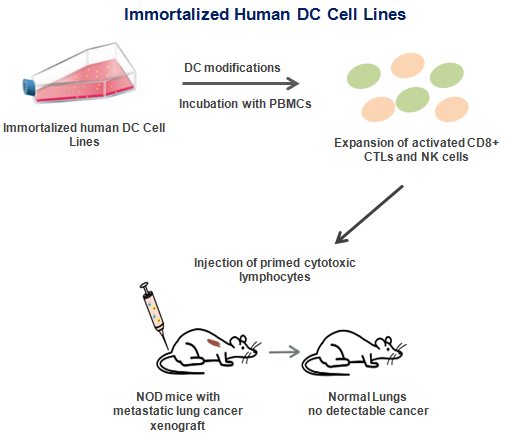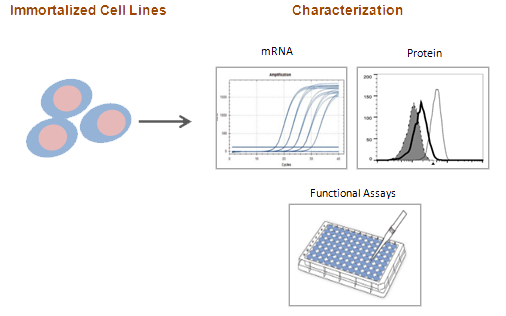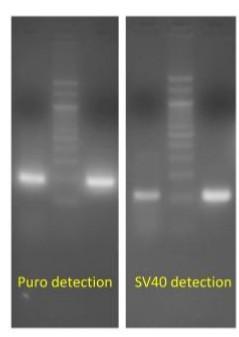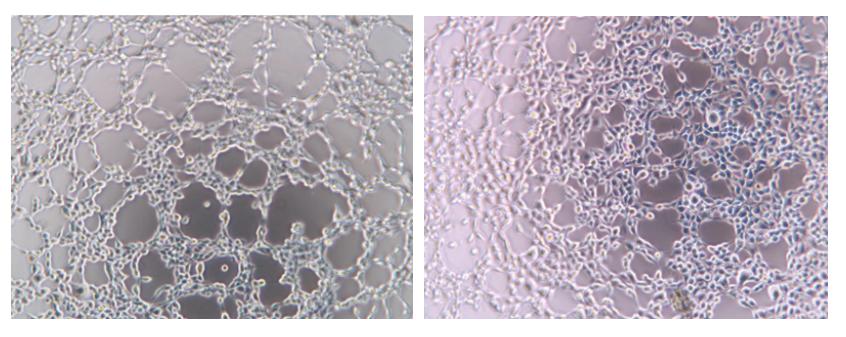Cell Immortalization Service
- Service Details
- Features
- Case Studies
- FAQ
- Explore Other Options
Creative Bioarray is offering cell immortalization service. Based on our experienced scientist team and elaborate technical platforms, we have been able to successfully immortalize cells from any species and any tissue with the function you need. Our custom immortalization service can significantly extend replicative capacity of your target cells, which saves your time and money over trying by yourself.
Cell culture is an essential tool to study the fundamentals of genetic background variables. With the development of personalized medicine, this applies increasingly to the development and safety testing of drugs. Currently, primary cells are used for these purposes. But primary cells are usually not available in sufficient numbers and the reproducibility of assays is limited. Applying this immortalization technology enables rapid, efficient, and reliable production of unlimited numbers of personalized cells. As such, these cell systems support mechnistic studies, epidemiological research, and tailored drug development.

Our Cell Immortalization Services
Cell immortalization technology
There are several methods for generating immortalized cells. One method is introduction of a viral gene that partially deregulates the cell cycle, such as EBV, SV40 T antigens and HPV-16 E6/7 gene. The cellular gene encoding human telomerase reverse transcriptase (hTert) has been successfully used for the expansion of several cell types that retain important propertiesin vitro. However, this approach is restricted to certain cell types as others either need the concerted action of additional immortalizing genes or the inactivation of tumor suppressor genes. Another method is to employed a lentiviral vector library encoding several selected genes, this works well with different cell types and allows the preserving of typical cell properties. Creative Bioarray will choose the best method to establish your personalized cell lines.
| Immortalization Genes | Immortalized Cell Types |
| SV40T antigens | Widely used for most cell types |
| hTERT | Commonly used for most cell types |
| EBV Genes | B Cells |
| HPV16-E6/E7 | Keratinocytes |
| Adenovial E1A | Epithelial cells from a broad range of rat tissues |
| CDK4 | Bronchial epithelial cells |
| P53-siRNA | A wide variety of cell types |
| cMyc | Prostate epithelial cells |
Source material
As Creative Bioarray is a premier manufacturer of primary cells, stem cells and immune cells. We can provide the starting material from any species and any tissues. If the cells are not directly available, we will esteblish an isolation protocol and then do the custom isolation for you.

- Primary Cells
Immortalized cell lines can serve as a simple model for more complex biological systems, for example, immortalized neural cell lines can be used for studies of neuronal development and restoration of function in models of neurological disease. - Immune Cells
Immunotherapy is a type of cancer treatment that boosts the body's natural defenses to fight cancer. Immortalization is a best way of generating large number of immune cells for treatment. For example, Wu et al. developed a method to establish immortalized and constitutively activated human primary blood DC lines, and explored various modifications to the DCs to enhance their immunotherapeutic potential. - Stem Cells
Stem cells have been shown to provide a plentiful, renewable source of cell replacement. However, as expected for somatic stem cells, following a finite number of cell divisions in culture, stem cells will eventually undergo growth arrest and senescence. This limits their exploitation in the field of biotechnology and in pharmacological studies relying on large scale, high-throughput assays. Thus, immortalization of stem cells provide an initial attempt to overcome these limitations, leading to the establishment of immortalized stem cell lines. And immortalized human MSCs can continue to procduce angiogenic factors and cytokines, such as HGF and VEGF.
Phenotypic characterization
To characterize a new immortalized cell lines is really necessary. Immortalized cell lines can be characterized according to your requirements. Characterization may include mRNA expression, protein expression or functional assays.

Key Features

Immortalized cell lines from any species and any tissues with the function you need

Phenotypic characterization according to your requirements

Projects are designed and handled by experienced scientists.

Short turn-around time.

Competitive pricing
Case Studies
- Human Umbilical Vein Endothelial Cell Immortalization
- Transgene Expression Analysis
- Morphology of Immortalized Human Umbilical Vein Endothelial Cells-SV40
- Cell Marker Characterization
- Function Analysis: Neo-angiogenic potential
Human Umbilical Vein Endothelial Cell Immortalization
Immortalized Human Umbilical Vein Endothelial Cells-SV40 (Cat No.: CSC-I9038L) from Creative Bioarray was developed from human umbilical vein endothelial cells by transduction with a lentiviral expression vector containing the SV40T gene. The cell line was continuously cultured for more than 20 passages without showing signs of growth retardation or replicative senescence whereas the parental cells senesced after having reached 4 passages. Immortalized Human Umbilical Vein Endothelial Cells-SV40 (Cat No.: CSC-I9038L) respond to VEGF treatment and form neoangiogenic webs on Matrigel.
Transgene Expression Analysis
 Figure 1. PCR amplification indicated that SV40 large T antigen and puromycin resistance gene appeared in Immortalized Human Umbilical Vein Endothelial Cells-SV40. Assay was run on genomic DNA samples from the immortalized cell line. The gel images show that PCR products have 112bp SV40 band and 190band. The left panel shows the detection of puromycin resistance gene, lane 1: Immortalized Human Umbilical Vein Endothelial Cells-SV40, lane 2: ladder, lane 3: positive control. The right panel shows the detection of SV40 large T antigen, lane 1: Immortalized Human Umbilical Vein Endothelial Cells-SV40, lane 2: ladder, lane 3: positive control.
Figure 1. PCR amplification indicated that SV40 large T antigen and puromycin resistance gene appeared in Immortalized Human Umbilical Vein Endothelial Cells-SV40. Assay was run on genomic DNA samples from the immortalized cell line. The gel images show that PCR products have 112bp SV40 band and 190band. The left panel shows the detection of puromycin resistance gene, lane 1: Immortalized Human Umbilical Vein Endothelial Cells-SV40, lane 2: ladder, lane 3: positive control. The right panel shows the detection of SV40 large T antigen, lane 1: Immortalized Human Umbilical Vein Endothelial Cells-SV40, lane 2: ladder, lane 3: positive control.
 Figure 2. Identification of LV-SV40LT lentivirus-expressing cells by q-PCR. Primary Human Umbilical Vein Endothelial Cells were used as normal control.
Figure 2. Identification of LV-SV40LT lentivirus-expressing cells by q-PCR. Primary Human Umbilical Vein Endothelial Cells were used as normal control.
Morphology of Immortalized Human Umbilical Vein Endothelial Cells-SV40
 Figure 3. Morphology of Immortalized Human Umbilical Vein Endothelial Cells-SV40 in culture.
Figure 3. Morphology of Immortalized Human Umbilical Vein Endothelial Cells-SV40 in culture.
Immortalized Human Umbilical Vein Endothelial Cells-SV40 (Cat No.: CSC-I9038L) are characterized by the typical endothelial morphology.
Cell Marker Characterization
 Figure 4. Expression of endothelial markers in Immortalized Human Umbilical Vein Endothelial Cells-SV40.
Figure 4. Expression of endothelial markers in Immortalized Human Umbilical Vein Endothelial Cells-SV40.
Immortalized Human Umbilical Vein Endothelial Cells-SV40 (Cat No.: CSC-I9038L) are characterized by the homogenous expression of cell-type specific markers such as vWF. Cell nuclei are counterstained with DAPI.
Function Analysis: Neo-angiogenic potential
 Figure 5. Capillary-like structures formed by Immortalized Human Umbilical Vein Endothelial Cells-SV40.
Figure 5. Capillary-like structures formed by Immortalized Human Umbilical Vein Endothelial Cells-SV40.
When inoculated onto Immortalized Human Umbilical Vein Endothelial Cells-SV40 form typical capillary like structures demonstrating neoangiogenic potential.
If you have any special needs in constructing an immortalized cell line, please contact us for this special service. Let us know what you need and we will accommodate you. We look forward to working with you in the future.
FAQ
1. What is cell immortalization?
Cell immortalization is a process by which cells are genetically modified to proliferate indefinitely. This is achieved through techniques such as virus introduction, genetic engineering, and chemical treatments, enabling the cells to bypass normal cellular senescence.
2. Why should I consider cell immortalization?
Immortalized cells provide a consistent, renewable, and reliable cell model for scientific research. This stability is crucial for drug screening, disease modeling, and genetic studies, ultimately saving time and resources by reducing experimental variability.
3. What types of cell immortalization services do you offer?
We offer a comprehensive range of cell immortalization services, including the immortalization of embryonic cells, stem cells, cancer cells, and various adult somatic cells. Techniques utilized include human Telomerase Reverse Transcriptase (hTERT), SV40 large T antigen, and E6/E7 genes.
4. Are there any risks associated with cell immortalization?
While cell immortalization can involve risks such as genomic instability and mutations, we implement stringent quality control measures at each step to minimize these risks and ensure the highest level of cell line integrity.
5. What is the success rate of your cell immortalization services?
Our cell immortalization services boast a high success rate, although specific rates may vary based on cell type and technique. We conduct a thorough assessment at the project outset to offer the most appropriate strategy and success rate expectations.
6. Do immortalized cells require special culture conditions?
Some immortalized cell lines may require specific culture conditions. We provide detailed culture guidelines upon project completion to ensure optimal cell growth and maintenance.
7. What are the costs involved in cell immortalization?
Project costs depend on various factors, including cell type, methodology, and complexity. Please contact Creative Bioarray for a detailed quote and breakdown of the service costs.
8. How do I initiate a cell immortalization project?
To start a cell immortalization project, please reach out to our customer service team. Our expert scientists will discuss your project requirements, technical needs, and timelines, offering comprehensive support throughout the process.
Ready to advance your research with reliable, immortalized cell lines? Contact us today to get started on your custom cell immortalization project with Creative Bioarray.
Quotation and Ordering
Our customer service representatives are available 24hr a day! We thank you for considering Creative Bioarray as your Cell Immortalization Service partner.
Explore Other Options

